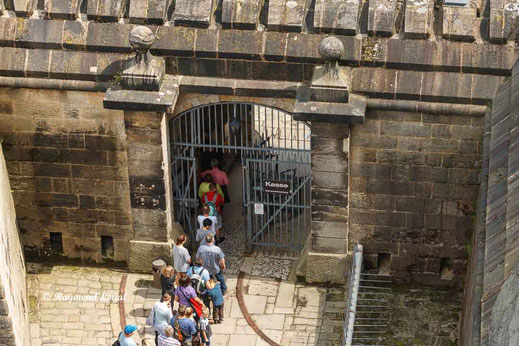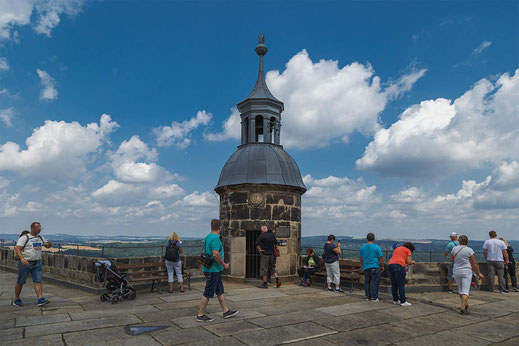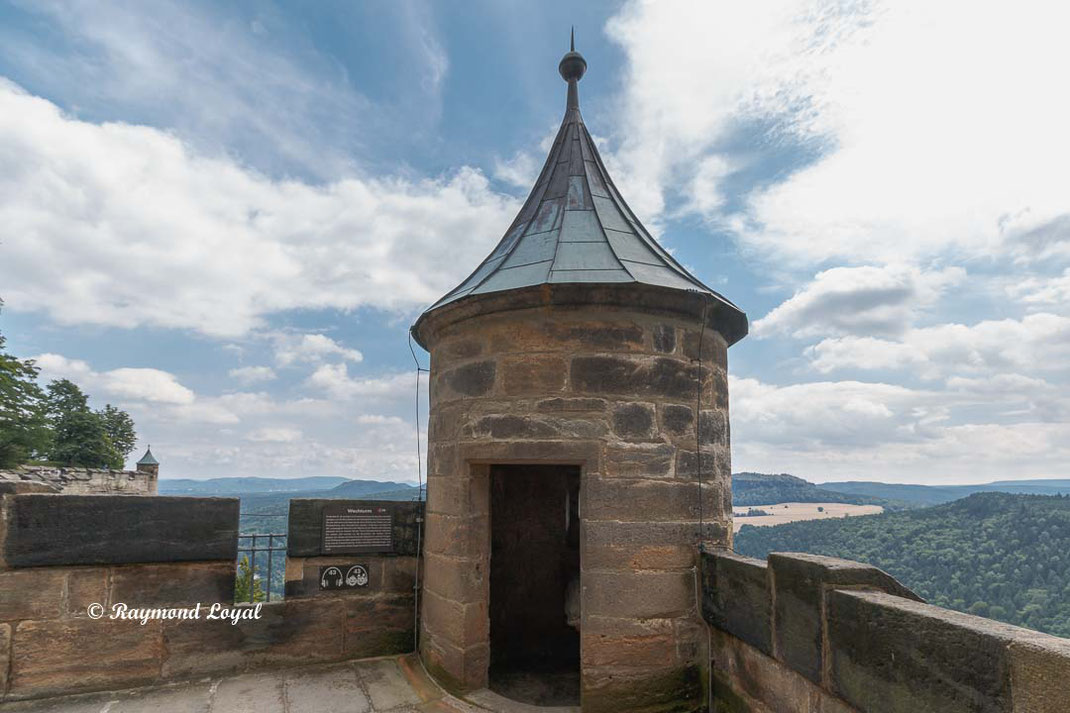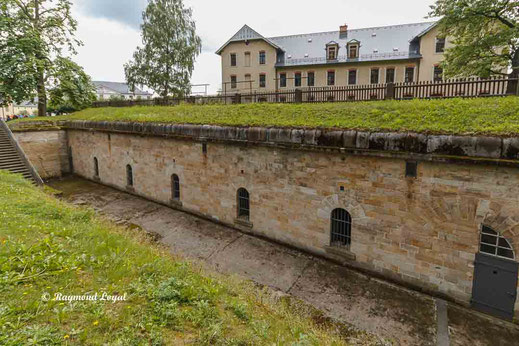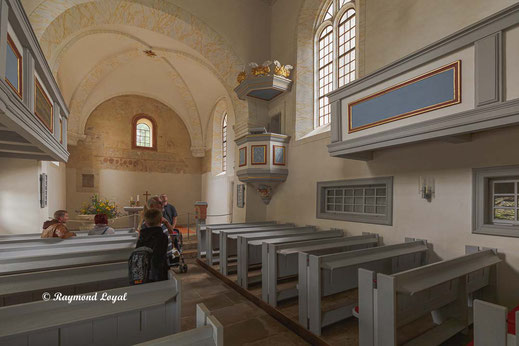Königstein Fortress
Interested in fortresses and military strongholds? Why not travel to Koenigstein? The hilltop fortress Koenigstein, nicknamed the Saxon Bastille, is not just a fortress it is an extraordinary experience and maybe an adventure. The fortress qualifies for superlatives such as being the largest mountain fortress in the whole of Germany and in Europe, because the complex covers an area of 9.5 ha and is situated on the plateau of a table hill, at a height of 246 metres on the left banks of the river Elbe. The same-named hill provided the name to the fortress.
Weather permitting, the fortress provides an excellent view of the Saxon Switzerland, aptly named because of its hilly countryside. The fortress is open to the public and can be visited every day. On the plateau a 2 km walkway leads the visitor alongside the battelements.
There is a lot of historic facts available on the fortress. However, and most probably, what really makes us going there is the site itself, the fantastic view over the countryside of Saxon Switzerland and all things great and small which are on display within the ramparts of the fortress.
General Information
Opening hours:
April to October: 0900h - 1800h
November to March: 0900h - 1700h
Last admission is one hour before closing time.
The fortress is open Monday to Sunday.
Address: D-01824 Königstein - follow the signposts to the car park.
Current Layout of the Fortress
- Georgenburg - George Castle
- Rothe Brücke - Red Bridge
- Hungerturm - Dungeon
- Seigerturm - Seiger Tower
- Neues Zeughaus - New Armoury
- Brunnenhaus - Well House
- Schatzhaus - Treasury
- Garnisonsbau - Garrison Building
- Altes Zeughaus - Old Armoury
- Magdalenenburg Magdalena's Castle
- Garnisonskirche - Garrison Church
- Friedrichsburg - Fredericksburg
- 1. Wachturm - Watchtower # 1
- 2. Wachturm - Watchtower # 2
- 3. Wachturm - Watchtower #3
- Königsnase - The King's Nose
- Blitzeiche - Lightning Oak
Koenigstein Fortress - Some Facts
The hilltop fortress, in her heydays, must have looked like the unassailable and impregnable fortress, sitting high up on the castle hill. Matter-of-factly the fortress was never conquered by any enemy force during its time as military stronghold.
The first mention of a castle on the hilltop is in 1241, when the area belonged to the Kings of Bohemia. In 1379 The Bohemian King Wenzel IV, obviously for the reason of being short of funds, had to pawn the castle to the bishop of Meissen Thimo von Colditz. Not one building of the early castle is still standing. Only roman-style remnants of the medieval castle chapel are still part of the building structure of the garrison church.
Before the idea of a frortess on the hill could materialise, Georg Duke of Saxony was keen to install a monastery on the hilltop. In 1516 twelf Celestin monks and the prior of Oybin monastery set up camp on the hill. The monastery was built on the western part of the hilltop (nowadays the place of gun battery number VIII). Entrance to the monastery was possible over steps carved into the rock, assumably between "Hempels Eck" and the "Horn". The monastery church used by the monks was the roman chapel.
The early-modern period called for some efforts to prop up defences and the traditional castle became obsolete because of new tactics and of course because of the increasing use of canons. One of the important basics of a fortress is the availability of sufficient water supplies. In order to manage that, Prince Elect August of Saxony had miners dig for a water well, which was successful at a depth of 152 metres. For the next 400 years that well continued to successfully produce water. Despite the well being in service, the Prince Elect of Saxony could not make up his mind whether or not to establish a fortress. Construction of the fortress beginns in spring 1589.

The Fortress
The entire hill top was armed with a surrounding battlement and three watchtowers, which are situated on the southern part of the complex. The gate house became part of the mighty Georgenburg which also included the battlements covering the entrance to the fortress (Streichwehr). Also the Old Armory (Altes Zeughaus, Christiansburg (Friedrichsburg) and the Old Barracks (Alte Kaserne) were built during the period between 1619 to 1681.
The gatehouse at Georgenburg is secured by a tenaille; with Georgenburg being the ravelin of the fortress. A ravelin is a detached outwork covering the inner works of a fortress. Georgenburg is also secured by the strongly built Georgen battery.
Friedrichsburg
The original building at the same place was called Christiansburg and doubled both as defensive installation and also served representative purposes. August the Strong turned that building into a baroque building with a double flight of stairs, as we know it today. The new building, then called Friedrichsburg was to fulfull representation purposes only.
Old Armory, Casemates, Magazines, Barracks
The inner works of the fortress are dispersed all over the place. Due to the high position of the plateau many buildings are far more exposed than would be the case at other fortresses that do not enjoy such a dominant position.
The visitor can walk alongside the parapet, which measures about 1800 metres.
It is remarkable that the fortress has had two different sets of hospital buildings. The wartime hospital was lodged in a bunker whereas the peacetime hospital is situated close to the Old Armor and overlooks the Elbe valley. Only during war and in case the fortress was besieged or lay under direct enemy artillery fire, the wartime hospital was used.
The artillery batteries are still there, only the original canons are no longer in their positions. However the visitor can visit the bunkers and the magazines and can, probably, imagine how live in the fortress must have been during war. And most certainly, serving in the fortress during peacetime must have been easy-going.

The Old Armory
Back in 1594 the Old Armory the Renaissance style building was purpously built to store all sorts of weapons and armory apart from powder, which was stored in bunkers. Groundfloor and hall are constructed with cross vaults and toscan pillars. In 1871 the upper floor undwent a conversion into a civil prison by adding single cells for the prisoners. The Old Armory is open to visitors.
Koenigstein Fortress - The Garrison Church
A garrison church at the fortress existed from 1596. During the Thirty-Years-War the building became derelict and worshippers had to use a room inside Georgenburg for services. Twenty years after the end of the war the church underwent a thorough restauration. A new sacristy was added. In 1681 the bell tower was built and in 1687 three bells were hung up in the tower. These bells had been part of the chime built for the palace tower in Dresden.





